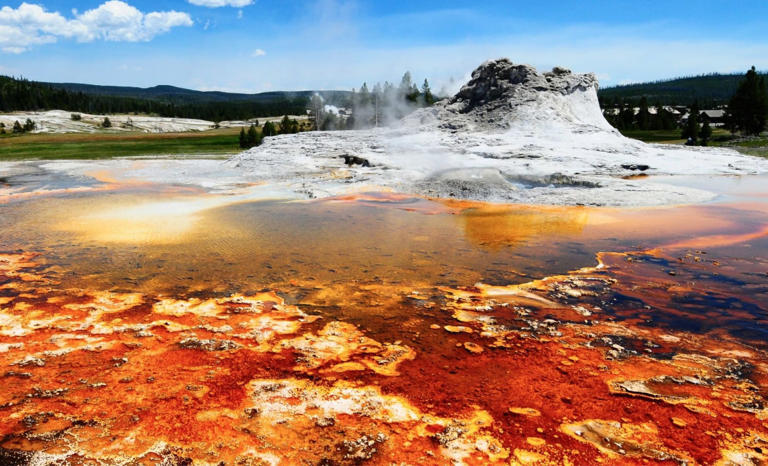A New Volcanic Vent Just Opened in Yellowstone—Is the Supervolcano Waking Up?
Story by Arezki Amiri
A newly openedvolcanic vent has been discovered in Yellowstone National Park, emitting thick plumes of steam and prompting scientists to investigate a potential link to the supervolcano’s complex hydrothermal system.
Discovery of a New Hydrothermal Feature in Roadside SpringsIn August 2024, a scientist observed an unfamiliar plume of steam rising from the Roadside Springs region of Yellowstone—an area known to lie above an extensive hydrothermal zone. This unexpected sight triggered a closer examination, revealing a newly formed vent with surface temperatures measured at 77°C (171°F).
What caught researchers’ attention wasn’t just the heat—it was also the fine gray siliceous clay coating around the vent. This thin layer of clay indicated that the opening was recent, not a long-established feature. The discovery was made and confirmed by scientists from the Yellowstone Volcano Observatory (YVO).
Interestingly, the new vent appears to echo a similar hydrothermal event recorded in March 2003. That earlier activity occurred on the opposite side of the same rhyolite lava flow, just west of Nymph Lake. According to YVO:
“This hydrothermal activity persists through this day but is much less energetic than when it first formed.”
This historical context has led scientists to suspect a possible underground connection between the two features. Both sites may be linked via a line of faults that runs from the Norris Geyser Basin to the Mammoth Hot Springs. This fault system could act as a conduit for hydrothermal fluids moving beneath the surface.
Active but Calming: A Plume That’s Losing SteamWhen it first appeared, the vent belched a thick steam cloud into the air, which persisted throughout the fall of 2024. By the time winter arrived, that visible activity had decreased significantly. The feature is still active, but it’s now releasing little to no steam.
What comes next is uncertain. Scientists are closely monitoring the vent to track any changes in its behavior. Whether it will fade like its 2003 counterpart or continue to evolve remains to be seen.
The appearance of new features like this vent is part of what makes Yellowstone such a scientifically vital location. Beneath the iconic geysers and hot springs lies a massive magma reservoir, constantly reshaping the park’s geology. The region is a supervolcano, still active, dynamic, and riddled with hidden geothermal movements.
Yellowstone isn’t just a picturesque national park—it’s a living laboratory where earthquakes frequently ripple through the ground, random hydrothermal explosions shake the crust, and newly emerging features provide clues to the behavior of the underlying volcanic system.
From Hot Springs to Life’s OriginsYellowstone’s bubbling hot springs are not just geological curiosities. The microbial ecosystems living in these toxic environments offer insights into the kinds of extreme adaptations life can make. Studying these microbes may also help scientists understand how life originated on Earth, or even how it might survive on other worlds.
These unique life forms thrive in hostile conditions—boiling temperatures, mineral-laden waters, and acidic pools—and are part of what makes Yellowstone a globally significant site for astrobiology and extreme environment research.
As the Yellowstone Volcano Observatory notes, “there’s always something new” in the park’s vast geothermal network. Whether it’s a change in geyser behavior, a shift in underground fluid flow, or the sudden appearance of a vent like the one discovered in 2024, each new feature deepens our understanding of this restless, fiery landscape.
Enjoyed this article? Subscribe to our free newsletter for engaging stories, exclusive content, and the latest news.
For more news like this, visit Dailygalaxy.com.

Water boiling in the Crested Pool in Yellowstone National Park | The Daily Galaxy --Great Discoveries Channel © Daily Galaxy UK

The first sign of the vent was a plume of steam that hadn’t been there before. (Mike Poland/USGS) © Daily Galaxy UK

The new vent with its thin coating of pale gray clay. (Jefferson Hungerford/USGS/Yellowston
usgs.gov |







